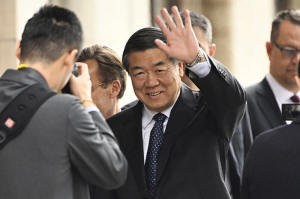Top Chinese, US trade officials huddle in Sweden for second day of
thorny talks over tariffs
[July 29, 2025] By
JAMEY KEATEN
STOCKHOLM (AP) — Chinese and U.S. trade officials arrived for a second
day of meetings in the Swedish capital Tuesday to try to break a logjam
over tariffs that have skewed the pivotal commercial ties between the
world's two largest economies.
U.S. Treasury Secretary Scott Bessent and Chinese Vice Premier He Lifeng
made no public comments to reporters after the first day of talks that
lasted nearly five hours behind closed doors at the Swedish prime
minister’s office Monday.
Before the talks resumed Tuesday, Swedish Prime Minister Ulf Kristersson
met with Bessent and U.S. trade representative Jamieson Greer over
breakfast.
The United States has struck deals over tariffs with some of its key
trading partners — including Britain, Japan and the European Union —
since President Donald Trump announced “Liberation Day” tariffs against
dozens of countries in April. China remains perhaps the biggest
unresolved case.
“The Chinese have been very pragmatic," Greer said in comments posted on
social media by his office late Monday. “Obviously we’ve had a lot of
tensions over the years. We have tensions now, but the fact that we are
regularly meeting with them to address these issues gives us a good
footing for these negotiations.”
“Whether there will be a deal or not, I can’t say,” Greer added in the
clip posted on X from MSNBC's “Morning Joe”. "Whether there’s room for
an extension, I can’t say at this point. But the conversations are
constructive and they’re going in the right direction.”
Many analysts expect that the Stockholm talks, at a minimum, will result
in an extension of current tariff levels that are far lower than the
triple-digit percentage rates as the U.S.-China tariff tiff crescendoed
in April, sending world markets into a temporary tailspin.

[to top of second column] |

Chinese vice prime minister He Lifeng, center, waves as he arrives
at Rosenbad before trade talks between the US and China in
Stockholm, Sweden, July 28, 2025. (Fredrik Sandberg/TT News Agency
via AP)
 The two sides backed off the brink
during bilateral talks in Geneva in May and agreed to a 90-day pause
— which is set to end on Aug. 12 — of those sky-high levels. They
currently stand at U.S. tariffs of 30% on Chinese goods, and China's
10% tariff on U.S. products.
Other issues on the agenda include access of American businesses to
the Chinese market; Chinese investment in the U.S.; components of
fentanyl made in China that reach U.S. consumers; Chinese purchases
of Russian and Iranian oil; and American steps to limit exports of
Western technology, like chips that help power artificial
intelligence systems.
Wendy Cutler, a former U.S. trade negotiator and now vice president
at the Asia Society Policy Institute, said that Trump’s team would
face challenges from “a large and confident partner that is more
than willing to retaliate against U.S. interests.”
Rollover of tariff rates “should be the easy part,” she said,
warning that Beijing has learned lessons since the first Trump
administration and “will not buy into a one-sided deal this time
around.”
On Monday, police have cordoned off a security zone along
Stockholm’s vast waterfront as rubbernecking tourists and locals
sought a glimpse of the top-tier officials through a phalanx of TV
news cameras lined up behind metal barriers.
Flagpoles at the prime minister's office were festooned with the
American and Chinese flags.
All contents © copyright 2025 Associated Press. All rights reserved |